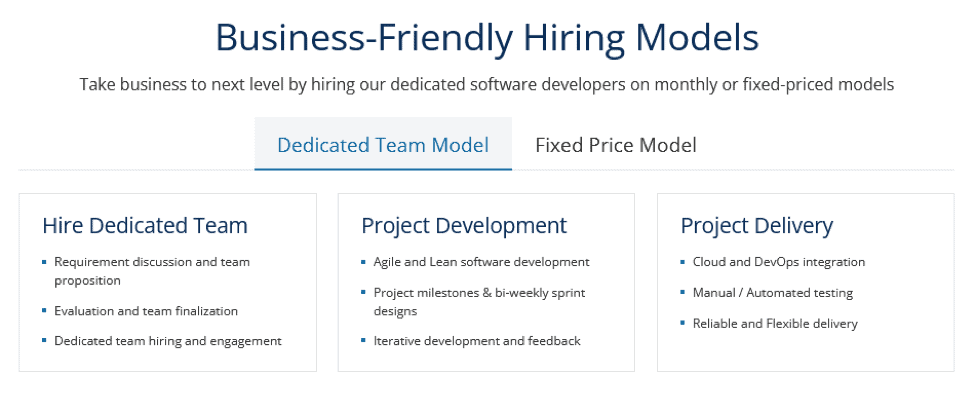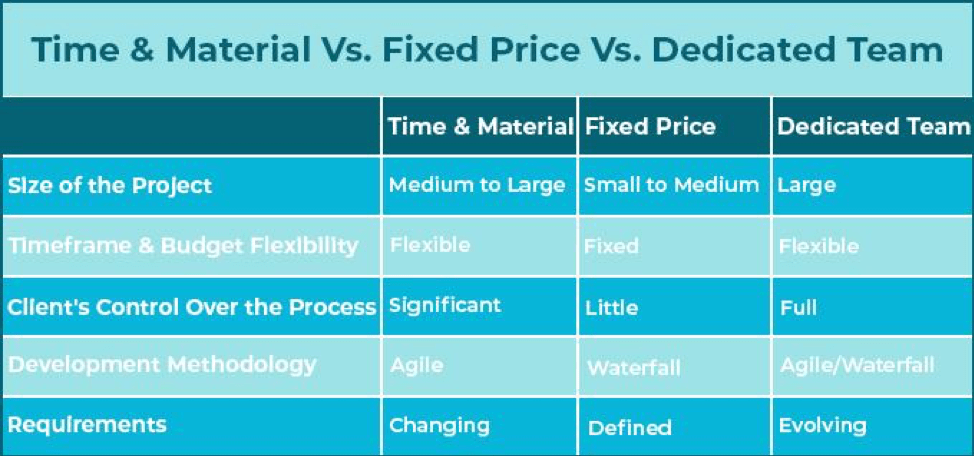Contents
1. Introduction
Although earlier, outsourcing contracts were usually based on a fixed price model, another often utilised business model has been time-and-materials. Selecting the appropriate project model may be challenging, as it must follow the operational procedures, the contract’s needs and objectives, as well as the vendor’s general expenditures.
While the discussion has always been debatable whether to build your own dedicated software development team, opt for a fixed price model, or Time and materials models, it is worth mentioning that businesses nowadays use hybrids and combinations. These are the most frequent and time-tested software development pricing models, each with its own perks and cons.

So before you finalise, let’s have a quick bird’s eye view of each of these three models to make you realise the best match for your project requirements.
Table of Content
- Introduction
- What Are The Different Engagement Models, And Why Are They Required?
- Dedicated development team Model
- Fixed price Model
- Time and materials Model
- Conclusion
2. What Are The Different Engagement Models, And Why Are They Required?
A connection between a customer and an outsourced vendor is defined by its engagement model. Because the software development engagement model is similar to a contract, both sides, namely the client and the outsourced provider, should communicate openly with one another. For instance, once the contract’s conditions have been agreed upon, the procedures will be governed according to the chosen work model.
Thus, your project engagement model should:
- Based on the client’s specifications.
- Specify the extent to which the customer has influence over the procedures.
- Determine an appropriate deadline (the duration of the project is determined by the client’s business concept and the team’s involvement).
- Discuss the pricing approach and convey whether the budget is fixed-price or variable.
While there is no “universal” model that will satisfy all of the criteria and demands of any firm and development process, such models are intended to serve as the framework for future client-vendor interactions.
3. Dedicated development team Model
The dedicated team approach is appropriate for long-term projects with ambiguous criteria that change as the scope of the project evolves. Additionally, it is utilised when the customer’s own team lacks specific talents or experience. A dedicated outsourced team can be integrated into a client’s team to complete high-quality, one-of-a-kind, and customised projects without requiring the client’s core team to expand.
Monthly payments depending on team size and include fixed service expenses are the pricing model for dedicated teams.
What is the client’s role while collaborating with a dedicated team? As a customer, you may communicate with your assigned team and monitor the project’s progress. This enables you to maintain a balance between your in-house and dedicated outsourced teams and respond to changing conditions.
The following are the characteristics of a smooth software development process:
- Together with the outsourcing business, the client specifies the number of people required for the project and their capabilities.
- The client is in charge of managing and controlling the project/product and team.
- In certain situations, the management process is designed in such a way that the software product is controlled by the outsourcing provider.
3.1 Advantages
There are several advantages of the dedicated team engagement model; we will discuss the most significant ones below.
Cost-Effectiveness
One of the main project requirements is Cost-effectiveness for the following reasons: Hiring a software development team for a project is typically significantly less expensive than recruiting in-house professionals, even more so if the team is situated in a nation with lower development expenses than, say, the United States.
A team of professionals with a track record of successfully completing comparable projects to yours will not break the bank and will complete the essential work without sacrificing the product’s quality.
It’s an excellent opportunity to save money on human resources and eliminate the expense associated with hiring new staff.
Concentrated Approach
Another significant advantage is a targeted approach. All parties participating in the project will devote their whole attention to it, avoiding any potential distractions.
That is not all. The team is adaptable—it may be reconfigured at any moment to meet the project’s current requirements and demands, assuring the project’s completion and success.
Transparent Management
On request, the customer can obtain time tracking and activity management systems used by dedicated teams. This keeps everyone on the same track and allows the customer to monitor the project’s development.
Clear contact via messaging apps such as Slack and Telegram, as well as regular reporting, will also help to transparent management.
Relevant Experience and Expertise
External developers provide specialists with the appropriate skills and knowledge.
And, quite frequently, this also indicates that these individuals have performed similar tasks to yours. They can offer valuable guidance and consider even the smallest things that you may have overlooked.
After a period of collaboration, they have refined their workflows and mastered the art of delegation. You won’t have to start from zero or deal with any disputes, and it’s also quite advantageous.
Tight Collaboration
The client and team members collaborate closely to accomplish a single objective and provide visible results. They not only interact on a daily basis but also engage in brainstorming sessions to determine the process’s strengths and weaknesses and enhance routines and long-term strategy.
This technique is critical for resolving unanticipated difficulties and eliminating project-related obstacles in a timely manner.
3.2 Drawbacks
You have the necessary resources at your disposal. With a committed staff, you maintain the greatest share of accountability for the project’s success. You must devote time to connecting with your team and maintaining control over procedures and scalability. Additionally, you must have a thorough understanding of the complexities of your project in terms of managing it efficiently.
Inefficiency when working on short-term projects or when the workload is variable and unexpected. While the dedicated team model is ideal for long-term cooperation, it is less appropriate for small, straightforward online projects that would gain more from a fixed-price engagement model.
High cost. Since you are effectively renting the squad, the lump sum payment may be considerable. Generally, the cost per unit of work will remain cheaper than that of a fixed-price project, although this is something to consider.
4. Fixed price Model
This approach is defined by specified project criteria, predetermined timelines, and a preset budget. After thoroughly scoping your requirements, your chosen partner contacts you with a proposal, including the agreed-upon pricing, project deliverables, and deadlines. Once an agreement is achieved, work on your project begins in strict accordance with the proposal’s specifications, with very little opportunity for variation.
4.1 Advantages
Cost certainty, little financial risk. After the contract specifies the project’s cost, you’ll know precisely how much you’ll spend. Without previous warning, the software firm cannot overcharge you. With this approach, the risk of going over budget is almost eliminated.
There is a set deadline. With a definitive scope and precise features list, the development team can predict the project’s schedule more accurately. They can then develop a detailed strategy with certain dates.
A straightforward development timetable. You’ll always be aware of which features will be incorporated over the course of the project. Additionally, you’ll be able to determine whether there is a delivery delay.
Client management is not required. Because the project’s specifics are complete, you may delegate project management to the developer team. There is no requirement for constant monitoring on your part, which allows you to reduce your involvement to a minimum.
4.2 Drawbacks
The truth of the majority of web projects is that patrons do not know if they have requested the correct item until it is developed and used. As a result, the primary source of contention is typically project scope and modification requests.
Inflexibility. A fixed-price project’s scope is predefined (requirements). Due to the fact that the cost cannot be changed, the work scope is significantly less adaptable. Requirements evolve over time as functionality is clarified, which can result in disputes and delays. While competent developers will want to offer you the best solution possible, a fixed-price project may impair their capacity to do so. Fixed-price projects are unsuitable for those that cannot settle on features or quality.
Client participation is reduced. Additionally, the reduced necessity for customer engagement once the requirement has been agreed upon might result in isolated development where the finished product, although technically meeting the requirements, falls short of the client’s expectations.
5. Time and materials Model
The project cost under this approach is determined by the number of resources and time spent by the development firm on your project. It’s critical to remember that the customer pays for the whole time necessary to complete a work, not just the time spent relaxing.
As a client, it becomes critical to define the project’s scope and supervise it. The more precise the specifications are stated, the sooner the project will be delivered to you. On the other hand, if your criteria are vague, rework will take longer.
If you fail to offer a specific definition of your demands, you will be charged an additional fee since you are paying on a timely basis, which can be defined as hourly, daily, or weekly.
5.1 Advantages
Complete adaptability. Due to the Agile methodology’s use, it is feasible to make immediate adjustments inside a project as needed. T&M contracts enable a client-company to alter features, alter the scope of the project, accommodate alternative designs, or substitute materials.
You economise. There is no requirement to spend a lot of time preparing meticulously because the majority of jobs are chosen throughout the development phase. Developers can begin work immediately after signing a T&M contract.
The ever-changing workflow. The ability to make judgments throughout the development process and enhance a plan is advantageous for large-scale and middle-sized projects in terms of projected outcomes.
5.2 Drawbacks
Besides a not-to-exceed clause and cost limitations, you may run into difficulties during negotiations or with contractors abusing these omitted elements.
You must deal with the time-consuming procedure of constantly tracking the materials used on the assignment as well as billable hours, which can be challenging to do when operating your own new biz. A T&M contract requires a higher level of engagement than a fixed-price contract.
Because there is no defined budget, overall expenditures might easily surpass what you anticipate paying initially.
Because there are several unknown factors in the project that result in a T&M contract, there are numerous possible downsides. It is essential to examine carefully if the drawbacks exceed the danger. If not, you may want to take some more time to conduct additional research and explore a fixed-price contract instead.
6. Dedicated development team Vs Fixed price Vs Time and materials engagement models

As described specifically in the image above, you may focus on five criteria from the size of your project to its requirements. However, each model represents a different aspect of the presumed result. On the predictable contrary, the dedicated team model seems to take over the plane swiftly.
7. Conclusion
As can be seen, each of the techniques mentioned above offers several pros and downsides. Choosing the optimal form of collaboration is entirely dependent on the details of your project.
I recommend employing a dedicated development company if you have a long-term active project that requires close monitoring by a skilled project manager or dedicated developers.
The time and material approach are effective for large and small projects since they give you complete power over the government and budget.
While the fixed pricing model is an excellent starting point for establishing a trustworthy commercial relationship with a software development company, it might prove inefficient for long-term projects.

